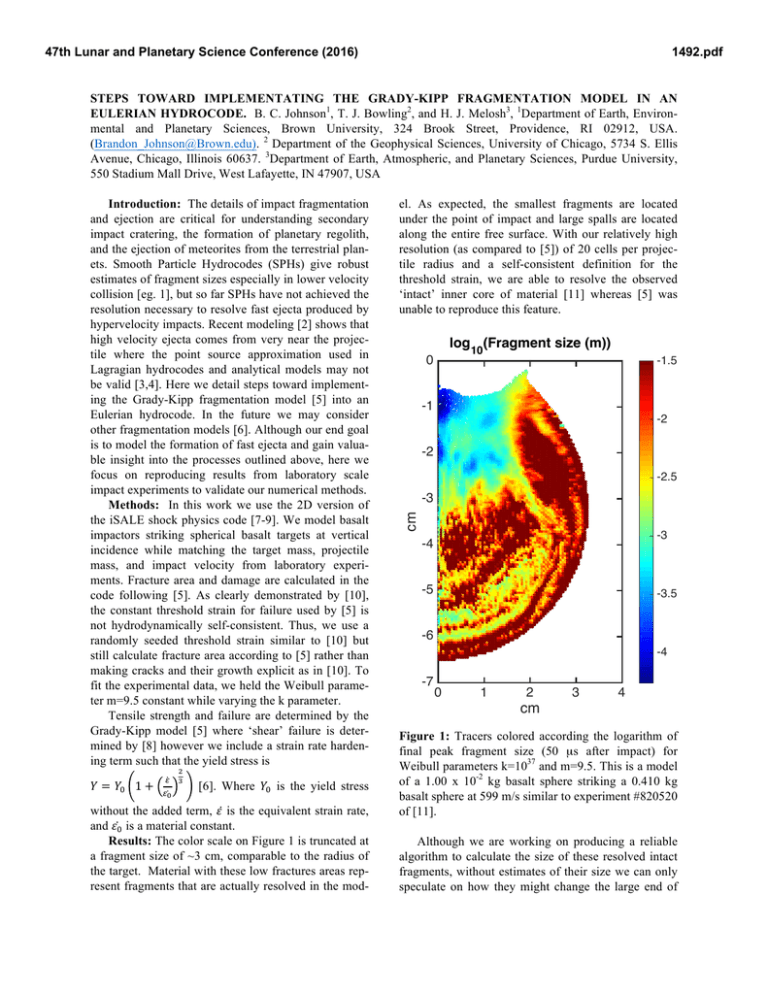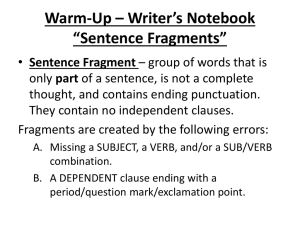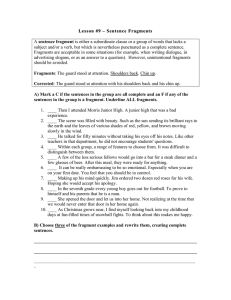1492
advertisement

47th Lunar and Planetary Science Conference (2016) 1492.pdf STEPS TOWARD IMPLEMENTATING THE GRADY-KIPP FRAGMENTATION MODEL IN AN EULERIAN HYDROCODE. B. C. Johnson1, T. J. Bowling2, and H. J. Melosh3, 1Department of Earth, Environmental and Planetary Sciences, Brown University, 324 Brook Street, Providence, RI 02912, USA. (Brandon_Johnson@Brown.edu). 2 Department of the Geophysical Sciences, University of Chicago, 5734 S. Ellis Avenue, Chicago, Illinois 60637. 3Department of Earth, Atmospheric, and Planetary Sciences, Purdue University, 550 Stadium Mall Drive, West Lafayette, IN 47907, USA 𝑌 = 𝑌# 1 + & &' ( ) [6]. Where 𝑌# is the yield stress without the added term, 𝜀 is the equivalent strain rate, and 𝜀# is a material constant. Results: The color scale on Figure 1 is truncated at a fragment size of ~3 cm, comparable to the radius of the target. Material with these low fractures areas represent fragments that are actually resolved in the mod- el. As expected, the smallest fragments are located under the point of impact and large spalls are located along the entire free surface. With our relatively high resolution (as compared to [5]) of 20 cells per projectile radius and a self-consistent definition for the threshold strain, we are able to resolve the observed ‘intact’ inner core of material [11] whereas [5] was unable to reproduce this feature. log10(Fragment size (m)) 0 -1.5 -1 -2 -2 -2.5 -3 cm Introduction: The details of impact fragmentation and ejection are critical for understanding secondary impact cratering, the formation of planetary regolith, and the ejection of meteorites from the terrestrial planets. Smooth Particle Hydrocodes (SPHs) give robust estimates of fragment sizes especially in lower velocity collision [eg. 1], but so far SPHs have not achieved the resolution necessary to resolve fast ejecta produced by hypervelocity impacts. Recent modeling [2] shows that high velocity ejecta comes from very near the projectile where the point source approximation used in Lagragian hydrocodes and analytical models may not be valid [3,4]. Here we detail steps toward implementing the Grady-Kipp fragmentation model [5] into an Eulerian hydrocode. In the future we may consider other fragmentation models [6]. Although our end goal is to model the formation of fast ejecta and gain valuable insight into the processes outlined above, here we focus on reproducing results from laboratory scale impact experiments to validate our numerical methods. Methods: In this work we use the 2D version of the iSALE shock physics code [7-9]. We model basalt impactors striking spherical basalt targets at vertical incidence while matching the target mass, projectile mass, and impact velocity from laboratory experiments. Fracture area and damage are calculated in the code following [5]. As clearly demonstrated by [10], the constant threshold strain for failure used by [5] is not hydrodynamically self-consistent. Thus, we use a randomly seeded threshold strain similar to [10] but still calculate fracture area according to [5] rather than making cracks and their growth explicit as in [10]. To fit the experimental data, we held the Weibull parameter m=9.5 constant while varying the k parameter. Tensile strength and failure are determined by the Grady-Kipp model [5] where ‘shear’ failure is determined by [8] however we include a strain rate hardening term such that the yield stress is -3 -4 -5 -3.5 -6 -4 -7 0 1 2 3 4 cm Figure 1: Tracers colored according the logarithm of final peak fragment size (50 µs after impact) for Weibull parameters k=1037 and m=9.5. This is a model of a 1.00 x 10-2 kg basalt sphere striking a 0.410 kg basalt sphere at 599 m/s similar to experiment #820520 of [11]. Although we are working on producing a reliable algorithm to calculate the size of these resolved intact fragments, without estimates of their size we can only speculate on how they might change the large end of 47th Lunar and Planetary Science Conference (2016) the calculated fragment Size Frequency Distribution (SFD). Figure 2 shows some estimates of the fragment SFD where the dashed curve simply uses the method of [5] and effectively ignores these intact fragments, which account for a large fraction of the target mass (Fig. 1). The solid lines assume all tracers with peak fragment sizes more than two times larger than the largest fragment given by the previous method make up a single large fragment. This assumption is also clearly problematic as there are many resolved fragments (Fig 1.). Based on the average cell mass resolved fragments may contribute to the SFD at normalized fragment masses exceeding 1.3x10-4. Although Weibull parameter k and m vary significantly with material, our best-fit to experiments occurs close to experimentally derived estimates of k=1.59x1038 and m=9.5 for Dresser basalt [5, 13]. Another potential problem with all current fragmentation models and an area for future exploration is the fact that fracture area is not accumulated during shear failure. There is clearly much work to be done, but our initial models represent an important first step toward a better understanding fast ejecta fragments, secondary cratering, and the ejection of meteorites. Because we are able to directly resolve large fragments, this model may help determine the size of spall plates without significant modifications. Cumulative number N 10 1492.pdf References: [1] Jutzi M. et al. (2009) Icarus, 201, 802-813. [2] Johnson B. C. and Melosh H. J. (2014) Icarus, 228, 347-363. [3] Head J. N. et al. (2002) Science, 298, 1752-1756. [4] Melosh H. J. (1984) Icarus, 59, 234-260. [5] Melosh et al. (1992) JGR, 97, 735759. [6] Ramesh K. T. et al. (2015) Planet. Space Sci., 107, 10-23. [7] Amsden, A. et al. (1980) LANL Report, LA-8095. [8] Collins G. S. et al. (2004) MAPS, 38, 217-231. [9] Wünnemann K. et al. (2006) Icarus, 180, 514-527. [10] Benz W. and Asphaug E. (1995) Comput. Phys. Commun., 87, 253-265. [11] Nakamura A. and Fujiwara A. (1991) Icarus, 92, 132-146. [12] Takagi Y. et al. (1984) Icarus, 59, 462-477. [13] Lindholm U. S. et al. (1974) Int. J. Rock. Mech. Min. Sci. Geomech. Abstr., 11, 181-191. Acknowledgements: H. J. M. acknowledges support from NASA grant NNX15AL61G. We gratefully acknowledge the developers of iSALE-2D, including Gareth Collins, Kai Wünnemann, Dirk Elbeshausen, and Boris Ivanov. Figure 2 (below): Comparison of cumulative fragment size frequency distributions for the impact conditions from Figure 1 to laboratory measurement (blue diamonds) and previous estimates from Lagrangian hydrocodes (red triangles). The black curve represents a separate run with different Weibull parameters. Laboratory impact Takagi et al. (1984) Exp #820520 3 Lagrangian Hydrocode Melosh et al. (1992) k=1E37 m=9.5 10 k=1E37 m=9.5 'normal' treatment 2 k=1E38 m=9.5 10 1 10 0 -6 10 10 -5 10 -4 10 -3 10 -2 Normalized Mass M/Mtarget 10 -1 10 0








